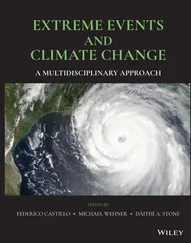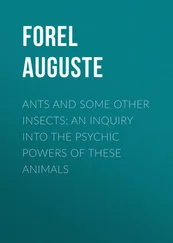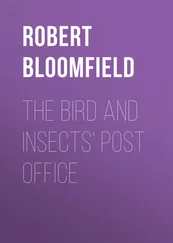Together with the many other parasitic ‘wasps’, ichneumons are a large and diverse group of creatures, which target a huge range of insect hosts. At one end of the scale are some of the smallest insects known (see page 90); at the other end are the giant ichneumon or sabre wasps in the genus Rhyssa.
Giant ichneumons need a host animal of suitable size to feed their equally giant larvae, and choose the larvae of another group of very large insects – the horntails. Horntails (Syrex species) are huge hornet-sized insects, named after their own large, stout tails, which they use to saw into fallen logs and rotten tree trunks to deposit their eggs. Their large grubs will chew burrows through the dead wood for between one and three years before finally emerging as adults.
Rhyssa females are able to detect chemicals given off by the Syrex larva, even through 4 cm (1 ½ in) of wood. The narrow 4 cm tail of a sabre wasp, usually longer than the rest of her body, is composed of three pieces – two thick outer strips form a protective sheath that covers the needle-thin ovipositor (egg-laying tube). Using her long legs and flexible abdomen as a gantry, she slowly pushes the slim egg tube down through the timber until she is able to parasitise the grub below. Her offspring is now assured of food to see it through to adulthood, but the horntail maggot is doomed.
| NAME |
stalk-eyed fliesin the family Diopsidae |
| LOCATION |
throughout the tropics, particularly Southeast Asia and Southern Africa |
| ATTRIBUTE |
eyes on thin stalks longer than their bodies |
It is a sad fact of life that males often fight each other for the attentions of females. The prize for the victor may be a harem and numerous offspring, but the cost in energy expenditure and bodily damage may be high, and life expectancy short. It is better to be able to size up an opponent before falling to blows, and stalk-eyed flies do this eye-ball to eye-ball.
Many groups of small tropical flies have broad heads, and this is taken to extremes in the family Diopsidae. More than 150 species in this family have heads so wide that the eyes are held out on unfeasibly long, thin horizontal stalks. Very often the head width (12-14 mm) is twice the length of the fly’s body (6-7 mm). Head width, or rather eye-stalk length, is directly proportional to body size, and a good indicator of body strength, which itself is directly linked to the fly’s nutrition when it was a larva. Male diopsids face of fin a head-to-head stalk-measuring contest. The winner gets the females, but the loser walks away unharmed.
This ritual behaviour is thought to have evolved because these tropical flies are relatively long-lived (12 months has been recorded), and because they have something important to guard. Other groups of small flies with shorter lifespans and narrower (but still relatively stout) heads actually come to head-butting bouts: they have little to lose so they just go for it. Male diopsids, on the other hand, have been observed repeatedly contesting for 200 consecutive days.
The valuable resources that male diopsids are defending are string-thin rootlets hanging down from the banks of small streams that run through the woodland in which they live. These apparently mundane bits of straggling vegetation are the prime night-roosting sites for large numbers of females. They gather here and all face upwards, the direction from which any potential predator will come. By fighting, or at least flaunting his broad head, a male diopsid rules the roost and secures his harem.
Brightest light generation
| NAME |
Jamaican fire beetle Pyrophorus noctilucus |
| LOCATION |
Central and South America |
| ATTRIBUTE |
brightest light production by any insect |
Several groups of insects can generate light, including the springtails, true bugs, fly larvae and especially the beetles. The well-known glow-worms and fireflies are neither worms nor flies, but beetles, and many species occur worldwide. Light-generating beetles use their lights to attract or communicate with potential mates. Some flash to a secret rhythm, while others emit a continuous pale glow. There has long been debate about which beetle species might be brightest and until recently comparisons were rather subjective, usually describing the similarity to a candle at some set distance as seen by the naked eye or to stars of various brightnesses. Supremely accurate photometers can now measure light production down to the atomic level, and a clear winner has been found – Pyrophorus noctilucus , a click beetle found in forests in the West Indies.
It is auspicious that this species should rank highest. In 1885 the French physiologist Raphael Dubois first isolated the compounds luciferin and luciferase by dissecting the glowing spots on the thorax of P. noctilucus. Similar chemicals are found in all light-emitting organisms. Light generation by living organisms (known as bioluminescence) is remarkable because it is ‘cold’. Using the old candle analogy, a firefly produces 1/80,000th of the heat that would be created by a candle of the same brightness.
The chemical reactions that produce light are based on the enzyme luciferase, which combines luciferin with oxygen and adenosine triphosphate (ATP). The significance of Dubois’s discovery was not fully understood for nearly 60 years until ATP was identified as the energy-carrying molecular currency in every living thing. In photosynthesis, light energy is captured by green plants and transformed into chemical energy in the form of ATP. This is used to make basic sugars and other substances from carbon dioxide in the atmosphere and water taken up by the roots. Photosynthesis absorbs light; bioluminescence releases light. The two reactions are equal, but the reverse of each other.
Most variable colour pattern
| NAME |
ten-spot ladybird Adalia decempunctata |
| LOCATION |
Europe |
| ATTRIBUTE |
over 80 different named colour or pattern forms |
Naming plants and animals should be a relatively straightforward procedure. Since the Swedish naturalist Karl von Linné (also Latinised to Carolus Linnaeus) developed the binomial (two-name) system, each organism has been given two names. Thus, for the seven-spot ladybird we have one name for the genus, Coccinella , meaning ladybird, and one for the particular species, septempunctata , meaning seven-spotted.
Except that nothing in nature is that straightforward. The common seven-spot always has seven spots, but the closely related ten-spot ladybird, Adalia decempunctata , very rarely has ten. In fact it can have anything down to no spots. It can be red with black flecks, black with yellow shoulder marks, chequered, netted, speckled or barred. When early naturalists put Linnaeus’s binomial system into use, they went to town with ladybirds.
There was sexmaculata and sexpunctata for six-spotted ones; octopunctata had eight spots, quadripunctata four; semicruciata was halfway to having a cross on its back; semifasciata had half a stripe; centromaculata had spots down the middle; triangularis had three marks; subpunctata had small spots; obscura was obscurely marked. There was only one small problem – all these were the same species.
Читать дальше












